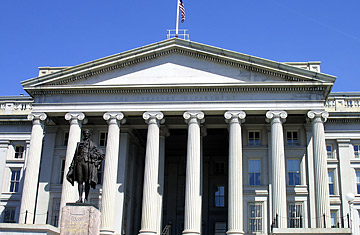
The Treasury building in Washington
Wall Street's sleepiest investment is all of a sudden its hottest one: Treasury bonds. The European debt crisis and stock-market volatility are combining to power Treasury bonds to one of their best years ever.
"Treasuries have become the place investors are going globally to hold their capital," says Tony Crescenzi, a portfolio manager at bond-market powerhouse PIMCO. "Investors want liquidity [the ability to buy and sell easily] and the Treasury market has that."
Treasury bonds have pulled back from their high at the end of last week, but they are still up significantly for the year. And many investors think the Treasury-bond run, despite the pause, will continue. On average, Treasury bonds, which are sold by the government to fund its debt, are up 3.7%, according to Barclays, which tracks bond returns. That might not sound like a lot, but for Treasuries it is. Treasury bonds typically have a lower return than other investments because they are generally lower-risk. The chance of the U.S. government going bankrupt is significantly lower than, say, a company going bankrupt or a home owner becoming unable to pay her mortgage. Because of that, Treasuries typically are referred to as a risk-free investment. The average annual return of Treasury bonds from 1802-1995 was 4.9%. That means Treasury bonds this year are on track to more than triple their historical average.
What's more, Treasuries are doing far better than most everything else on Wall Street these days. Stocks continued their recent bumpiness on Tuesday with the Dow Jones industrial average down another 112 points. May was the worst month for stocks in a year and a half. All told, shares have fallen 4% in value in 2010, according to the Standard & Poor's 500. Treasuries have outperformed most other bonds as well. Corporate bonds, for instance, are down 2.3% in 2010. Municipal bonds, which are sold by state and local governments, are up 3.3%.
Rising Treasury-bond prices are also good news for the economy. When bond prices rise, their yields fall. The yield is what a borrower has to pay on an annual basis to an investor who buys those bonds. On Treasuries, it is the government that is doing the borrowing and paying the yield. And the lower yields are coming at a time when the government is issuing a record amount of debt in order to pay for stimulus bills and fund the growing deficit.
All that borrowing causes some to believe that the rally in Treasury bonds could soon come to an end. At some stage, all the debt that the government is borrowing is likely to increase the risk that Uncle Sam won't be able to pay its bill. As a result, the thinking goes, the investors will demand higher interest rates for the increased risk. Even before that, the growing supply of Treasury bonds could outstrip demand from investors, pushing prices down and yields up. Lastly, an improving economy, as well as all that debt, could boost inflation, which could also cause Treasury rates to rise and prices, again, to fall.
"When you know the fundamentals, the recent rally in Treasury bonds seems like a disconnect," says Marilyn Cohen, CEO of Envision Capital and the author of The Bond Bible. "Does a 3.3% rate make a lot of sense with our national debt hitting $13 trillion?"
Nonetheless, Cohen says many are predicting the rate will trade down further throughout the summer, keeping the rally in Treasury prices alive at least for a few more months. And that's good news not just for investors, but everybody.
After all, it's not just the government that is paying less. Companies and individuals are paying less to borrow as well. Ten-year Treasury bonds serve as a benchmark for lots of borrowing rates, including, most importantly, home loans. So as the yield on the 10-year Treasury bond has fallen from 4% at the beginning of April to a recent 3.3% so too have mortgage rates, which typically average about 1.5 percentage points more than 10-year Treasuries. As a result, 30-year fixed home loans recently averaged 4.9%, according to Bankrate.com. And that has given some people new optimism that housing prices can continue to climb, despite the recent expiration of the home buyer tax credit and other government-sponsored efforts that have boosted residential real estate in the past few months.
"The discussion for most of the winter was that interest rates were going to go up," says Keith Gumbinger, who tracks loan rates at HSH Associates. "This persistent low level of interest rates is providing an unexpected support for the housing market."
